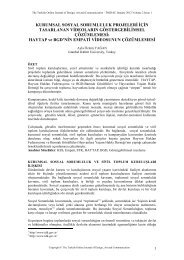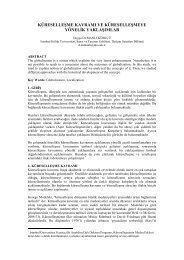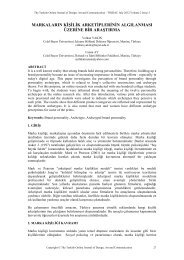aprıl 2012 - tojdac.org
aprıl 2012 - tojdac.org
aprıl 2012 - tojdac.org
Create successful ePaper yourself
Turn your PDF publications into a flip-book with our unique Google optimized e-Paper software.
The Turkish Online Journal of Design, Art and Communication - TOJDAC April <strong>2012</strong> Volume 2 Issue 2<br />
NEW CULTURAL HORIZONS: 3D<br />
Ioana MISCHIE<br />
I.L. Caragiale National University of Theatre and Film, Scriptwriting, Bucharest, Romania<br />
ioana_mischie@yahoo.com<br />
ABSTRACT<br />
Nowadays, we are witnessing new horizons in the contemporary cinema: the 3D technique’s giant<br />
step. The question is: is 3D a valid criteria The filmmaker wants you to live with the characters,<br />
offering Cinema an incredible flexibility as a multicultural platform. We have no universal scale<br />
at our disposal to measure the quality of a good story, of a memorable film, or even of an<br />
innovative technique. It is more a matter of communis opinio: what is generally accepted as good<br />
quality. At the start of the film you have to engage the minds and hearts of the audience. It’s<br />
crucial, it is a hyatus. The presentation is based on individual film analysis, exemplified by<br />
interviews with James Cameron (the director of “Avatar”), with Wim Wenders (the director of the<br />
3D documentary “Pina”) and as well, will take into consideration a case study focused on how the<br />
Romanian public understands 3D.<br />
Keywords: 3D, Cinema, New cultural wave, Storytelling<br />
1. INTRODUCTION<br />
In his book “The Century”, Alain Badiou asks himself : “How many years has century A<br />
hundred years” Is a century really defined by the number of years or by something more intrinsic<br />
than that His question is, in fact: are our criteria efficient enough Extrapolating, how can we<br />
measure three-dimensionality, culture, new media, digitalization, democracy, fairness or<br />
happiness Which one is our main criteria Box office Google searches Or maybe…<br />
something deeply connected to our inner selves, our inner perception, our own cultural imago<br />
mundi.<br />
When talking about cinema from the point of view of its technical evolution, more specifically<br />
about three-dimensionality it is fitting to begin with a question “Which facet of a diamond do you<br />
want to light” The light being our own analysis, and the facet being certain characteristics that<br />
we associate to 3D. Of course, it is tremendously hard, maybe almost impossible to predict the<br />
future of 3D, it’s even harder to explain the history of this technique, which was invented more<br />
than 100 years ago, but despite this it became well-known to the audiences only now. Therefore,<br />
it would be the most appropriate to discuss the present time of three-dimensionality, the way we<br />
perceive it, imagine it, feel it. How do our attitudes, as both audiences and filmmakers influence<br />
3-D and how does it influence us<br />
1.1. The Definition Of 3d As A Hyatus Between History And Evolution<br />
Nowadays, we are witnessing new horizons in the contemporary cinema: the 3D technique’s giant<br />
step. The question is: is 3D a valid criteria The filmmaker wants you to live with the characters,<br />
offering Cinema an incredible flexibility as a multicultural platform. We have no universal scale<br />
at our disposal to measure the quality of a good story, of a memorable film, or even of an<br />
innovative technique. It is more a matter of communis opinio: what is generally accepted as good<br />
quality. At the start of the film you have to engage the minds and hearts of the audience. It’s<br />
crucial, it is a hyatus.<br />
Copyright © The Turkish Online Journal of Design, Art and Communication 55









